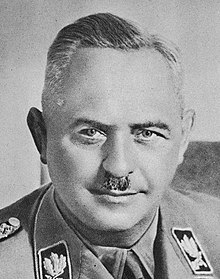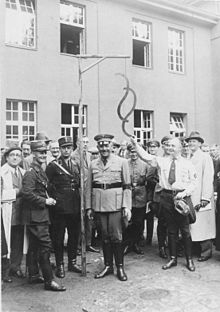Hanns Kerrl
Hanns Kerrl (born December 11, 1887 in Fallersleben , † December 15, 1941 in Paris ) was a German National Socialist politician . Among other things, he held the offices of Prussian Landtag President , Prussian Minister of Justice from April 21, 1933 to June 22, 1934 and Reich Minister for Church Affairs ( Reich Church Minister ) from 1935; in the latter, he was responsible for the DC circuit of churches in the German Reich . Since 1935 also head of the Reich Office for Regional Planning , he was mockingly called the Minister for Space and Eternity .
Life
Hanns Kerrl was born to Protestant parents in Fallersleben. His father was the headmaster there. After participating in the First World War , in which he received the Iron Cross 1st and 2nd class as a lieutenant , Kerrl became a judicial officer. Hanns Kerrl joined the NSDAP as early as 1923 and was involved in local politics. From 1928 to 1933 he was in the Prussian state parliament and in November 1933 became a member of the Reichstag for southern Hanover-Braunschweig. He was the Prussian Minister of Justice from 1933 to 1934 and during this time issued professional bans for Jewish notaries and lawyers .
Due to his Protestant upbringing, his comparatively scandal-free career and, not least, his low party number, he appeared to Hitler as the right man for the post of President of the Prussian Landtag after the NSDAP had won the majority of seats there in 1932. Hitler hoped to be able to appease the conservative camp during his “ seizure of power ” with a strictly Protestant and, on the surface, “original Prussian” educated citizen at the head of parliament.
Kerrl campaigned for the dissolution of the state parliament and new elections on March 5, 1933 in order to secure a majority for the NSDAP. This only came about through the withdrawal of the KPD mandate. By the laws for the synchronization of the states of March 31 and April 7, 1933 Prussia was subordinated to the Reich. From March 25, 1933 to 1935, he was Reich Commissioner for the Prussian Ministry of Justice. From April 21, 1933 to June 22, 1934, Kerrl was also the Prussian Minister of Justice. Qua office he was a member of the Prussian State Council . He introduced a system of National Socialist indoctrination for newly trained lawyers: All trainee lawyers had to undergo an eight-week training in the Jüterbog trainee camp. This camp was named " Community Camp Hanns Kerrl " and was passed through between 1933 and 1939 by 20,000 young lawyers. In 1933, Kerrl was one of the founding members of the National Socialist Academy for German Law by Hans Frank .
Kerrl enriched himself with the fruits of the persecution of the Jews that he carried out. Around 1935 he moved into the villa of the exiled Jewish merchant family Lindemann Am Rupenhorn No. 5, the high bank above the Stößensee in Berlin. The villa built by Bruno Paul in the Bauhaus style in 1929/31 was enlarged by Kerrl in 1937 by Friedrich Hetzelt .
From June 22, 1934, Kerrl was appointed Reich Minister without portfolio after he had previously had to cede his office as Prussian Minister of Justice to Franz Gürtner . Since 29 March 1935 Kerrl also had the management of the newly founded Zweckverbandes Nazi Party Nuremberg held that for the expansion and maintenance of the local Nazi Party Rally Grounds was responsible. On July 16, 1935, he was appointed Reich Minister for Church Affairs at the head of a new and short-lived ministry. In his new role, he was to ensure that the German Evangelical Church was finally brought into line . The Catholic Church had largely withdrawn into political neutrality through the Reich Concordat in 1933.
Kerrl became SA-Obergruppenführer and maintained connections with the German Christians who sympathized with National Socialism . He also assumed the role of mediator between strictly anti-church NSDAP leaders (such as Heinrich Himmler ) and the existing god-related ideologies of National Socialism (belief in God ), at least externally. He became a central figure in the beginning church struggle .
In the spring of 1939, Kerrl made an attempt to regulate the divided German Evangelical Church. To this end, he wanted to unite all church groups on the basis of common principles, which were to be signed by the German Christians and the neutral “center” to the moderate Confessing Church and presented to the public in a declaration. Kerrl hoped that this would change the attitude of the state and party towards the Protestant Church with Hitler. The disputes over the principles showed in a terrifying way how widespread and deeply rooted the aversion to Judaism was in German Protestantism . The first version of the principles, the “Godesberg Declaration” from the end of March 1939, achieved sad notoriety. This declaration represented a devastating mixture of Christianity and National Socialist worldview. It defined Christianity exclusively “folk-national” and was directed equally against Judaism and ecumenism .
Kerrl, who had had heart disease since 1936, died at the age of 54 on December 14, 1941 in Paris and was transferred to Berlin the following day. On December 20, there was a funeral service for him in the New Reich Chancellery, after which he was buried in the Dahlem forest cemetery. After his death, his State Secretary Hermann Muhs took over the ministerial office until 1945.
literature
- Hansjörg Buss: The Reich Ministry of Churches under Hanns Kerrl and Hermann Muhs. In: Manfred Gailus (Ed.): Perpetrators and accomplices in theology and church 1933–1945. Wallstein, Göttingen 2015, ISBN 978-3-8353-1649-2 , pp. 140–170.
- Carsten Nicolaisen : Kerrl, Hanns. In: New German Biography (NDB). Volume 11, Duncker & Humblot, Berlin 1977, ISBN 3-428-00192-3 , p. 534 ( digitized version ).
- Ernst Klee : The dictionary of persons on the Third Reich. Who was what before and after 1945. 2nd edition of the updated edition. Fischer Taschenbuch Verlag, Frankfurt am Main 2007, ISBN 978-3-596-16048-8 , p. 305.
- Konrad Fuchs : Kerrl, Hans. In: Biographisch-Bibliographisches Kirchenlexikon (BBKL). Volume 14, Bautz, Herzberg 1998, ISBN 3-88309-073-5 , Sp. 1147-1149. Pay attention to the misspelling of the first name, which also appears occasionally in other sources.
- Joachim Lilla , Martin Döring, Andreas Schulz: extras in uniform: the members of the Reichstag 1933–1945. A biographical manual. Including the Volkish and National Socialist members of the Reichstag from May 1924 . Droste, Düsseldorf 2004, ISBN 3-7700-5254-4 , p. 524 f .
Web links
- Literature by and about Hanns Kerrl in the catalog of the German National Library
- Newspaper article about Hanns Kerrl in the 20th century press kit of the ZBW - Leibniz Information Center for Economics .
- Hanns Kerrl in the database of members of the Reichstag
Individual evidence
- ^ Yearbook of the Academy for German Law. Edited by Hans Frank. 1st year Schweitzer Verlag, Munich / Berlin / Leipzig 1933/34, ZDB -ID 217185-5 , p. 254.
- ↑ Discussion of the explanation at the time . The original text from Renate Meurer, Reinhard Meurer: Texts of National Socialism: Examples, analyzes, suggestions for work. Oldenbourg Wissenschaftsverlag, Munich 1982, ISBN 3-486-84061-4 , pp. 41-45.
- ↑ Karl-Heinrich Melzer: The Spiritual Trust Council - Spiritual Leadership for the German Evangelical Church in World War II? (= Work on contemporary church history. Series B: Representations. Volume 17). Vandenhoeck and Ruprecht, Göttingen 1991, ISBN 3-525-55717-5 , p. 271 f. and note 13 (Zugl .: Kiel, Univ., Diss., 1988).
| personal data | |
|---|---|
| SURNAME | Kerrl, Hanns |
| BRIEF DESCRIPTION | German politician (NSDAP), MdR and Reich Minister, Reich Church Minister |
| DATE OF BIRTH | December 11, 1887 |
| PLACE OF BIRTH | Fallersleben |
| DATE OF DEATH | December 15, 1941 |
| Place of death | Berlin |


